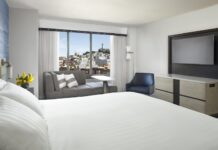All is well in the U.S. luxury hotel segment. For the first 11 months of 2015, chain affiliated luxury hotels sold over 27 million room nights, resulting in 76.3 percent occupancy. This is the highest year-to-date occupancy ever recorded, pointing toward the health and resilience of this sector.
The steady increase in occupancy can be explained by unabated room demand, which increased 2 percent in 2014 and an additional 1.2 percent through November 2015. The positive change in rooms sold points to a very healthy U.S. economy, as well as a product in high demand from business and leisure travelers alike. In fact, coming out of the last recession, the demand in 2015 was 12 million room nights higher than in the full year 2000 and 5 million room nights higher than in 2007.
The luxury segment hasn’t just seen growth in occupancy and demand since the United States pulled out of the great recession, it also fared better than its midscale and economy counterparts during the 2008 downturn, during which demand declined only -0.5 percent. Throughout the recession, other industries endured a lengthy, severe downturn, but luxury hoteliers saw a bounce-back as early as the last quarter of the 2009, with room demand increasing 10.5 percent. Room demand rebounded and with it, ADR growth returned in 2010.
The average cost of a luxury chain-affiliated room is now higher than ever. Through November 2015, hoteliers were able to charge $315 per room, an increase of $25 from 2007 and a 4.4 percent increase from year-to-date 2014. And, since 2010, growth in room rates has outpaced the average cost of inflation handily. That bodes well for the profitability of luxury hotels as revenue growth outpaces expense increases.
Interestingly, ADR is highest on Wednesday nights ($320), when occupancy hits about 80 percent. On an average Saturday, occupancy is just under 81 percent, but the ADR is just around $315, which leads to comparable revenues. In other chain scales we observe a very distinct difference between weekday and weekend room rates, with weekday ADRs notably higher, but not so in the luxury segment, where it seems operators have found the right mixture of service and amenity levels to charge high rates from both business and leisure guests.
RevPAR growth for luxury hotels has been over 5 percent since 2010. Growth rates have been declining since the high-water mark of 2011 (when they were greater than 11.4 percent) because occupancy growth is slowing, which is not surprising for hotels that are basically full. So with less possibility to raise occupancy, room rates have to be the majority contributor to RevPAR growth.
It will be interesting to see how group occupancies behave as hotels post record-breaking demand and occupancy levels. Since most of these rooms were booked and negotiated six to 18 months prior to arrival, there is hope that these blocks were signed with a robust ADR increase. Transient rates should increase at a more aggressive rate as limited new supply continues to only play a very moderate role and occupancies remain high. In fact, the STR pipeline only counts 6,900 rooms under construction of the total 141,000-construction-room pipeline. In sum, we expect luxury room ADR in 2016 to increase by around 5 percent and RevPAR to gain around 5.5 percent.
About the Author
Jan Freitag is senior vice president of STR.










